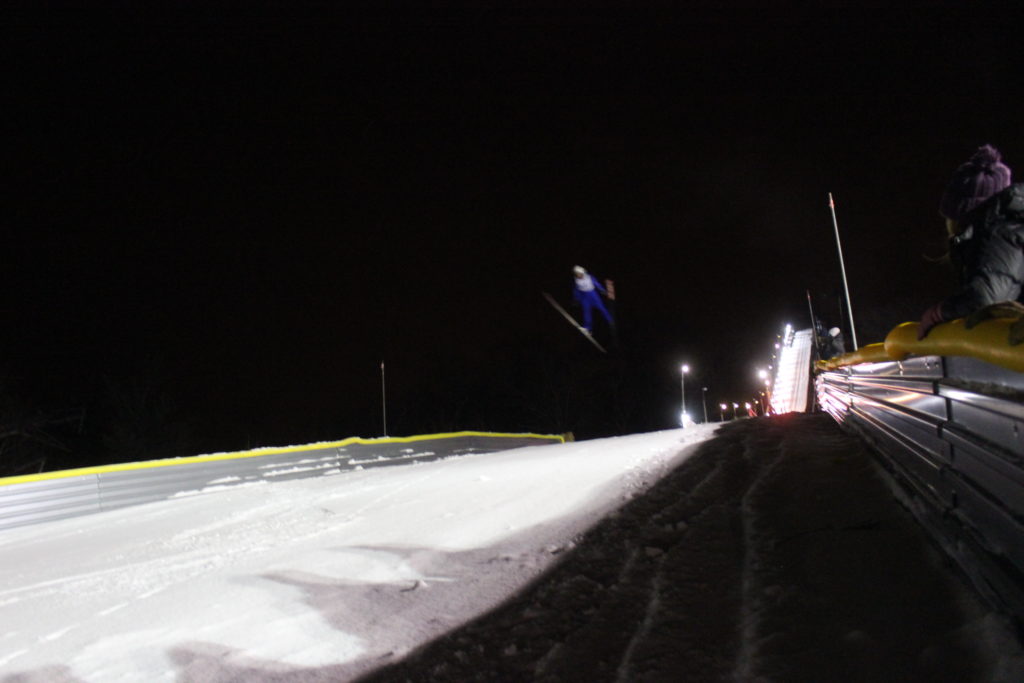A line of cars swarmed the remaining parking spots, leading up the snowy drive of Negaunee’s Suicide Bowl Road. Charging $20 per person, tailgators and attendees knew that whatever was ahead of them was worth paying for. Up ahead was a tall ski hill, bordered with bright lights that ripped down through the night sky like a giant pinball game. An orange hue lit up the city’s sky as two large bonfires whipped around, providing a warm welcome to tailgators and huddlers in their best winter apparel.
Skis slapping snow, the slip of kid’s snow pants sliding down snow mounds and tailgators cracking open another beer are all familiar sounds surrounding a ski jumping tournament. Fireworks bursted an SOS signaling a job-well-done and another safe, celebratory tournament all in the backyard of the chilly Negaunee.
From 6 to 9 p.m. ski jumpers, club members and the community gathered to attend the 132nd Annual Suicide Hill Ski Jump Tournament on Tuesday. Hosted by the Ishpeming Ski Club, the tournament was promoted by Mike Liagre, owner of 613 Studios, a custom art business that ran a tent at the tournament. He encouraged everyone to come watch United States and International ski jumpers “defy gravity as they soar off of the historic 90-meter, Suicide Hill.”
Liagre grew up in Detroit, but now that Negaunee is his home, he has taken the unique sport in stride. “There’s so many of these in the entire country and it’s in our backyard,” Liagre said. “I think this is something that everybody living up here should absolutely, 100 percent, cherish. For the folks that put this on, there’s a lot of sweat-equity that makes this work. This sport is just as Red Bull as it gets. They were jumping out here in the late 1800’s. It’s pretty honorable.”
A Norwegian military officer, Olaf Rye, was the first known ski jumper who, in 1808, jumped 9.5 meters in front of an audience of soldiers. Since then, the sport grew to aspiring jumpers and competitors, adapting their own technique and style.
Perhaps one of the most noticeable traits of ski jumping that differentiates itself from others is a technique showing the skis in a “V” shape while flying through the air. But why have jumpers adopted this unique trait and what makes it so special?
This wasn’t always the technique used, and many others were attempted before this stance. In 1985, Swedish jumper Jan Bokloev spread his skis shaping into a “V” instead of remaining parallel, proving to be a stronger and more efficient way of jump- ing. Though Bokloev was made fun of at first, his technique became so successful that every jumper was eager to adopt it. As far as competing, ski jump- ing has been a sport included in the Winter Olympics since 1924. Its first olympic appearance was in Chamonix, France.
Tuesday’s event brought many jumpers, including American Ski Jumper Michael Glasder, who competed at the recent PyeongChang 2018 Olympic Winter Games.
Another vendor selling merchandise was Kim Larson from Negaunee. Standing in the cold is part of the U.P. culture, but “hand warmers are a wonderful invention,” Larson laughed.
Though not as crowded as Tuesday’s event, Larson travels with her son, Isaac, to junior tournaments with competitors from various states close by. Larson’s son will compete on the big ramp in a few years, and said he’s nervous but thinks “it will be fun to fly in the air.”
Ski jumper Gwyneth Paavola is a member of USA Nordic, as well as a member of U.S. Ski and Snow- board. This is her first year competing as she participates in both skate skiing and ski jumping events. This combination is called “Nordic Combined.”
They build points every time they attend to jump at these events, which is a nice incentive,” Emily Paavo- la said, Gwyneth’s mother. “The first several years, it was putting the equipment on and going there and going down the hill, but this year [she] has been more competitive and getting ribbons.”
Paavola explained that her daughter would love to go down-hill skiing more often, but between jumping and cross-country skiing, those types of skiing is what takes precedent.
“We just drive here and put on the skis,” Paavola said. “It’s an enjoyable work out and [she] gets to have fun with the club too.”
Surrounded by ski hills, Paavola explained that there are cross-country trails used by jumpers that practice skate skiing. Likewise, the parents that come to these practices will ski on the trails as well.
“I like to get my work out in, skiing the trails while [she] does her jumping,” Paavola said. “I wish I had the opportunity when I was younger, so it’s nice to participate in this stuff with Gwyneth.”
When traveling to competitions in different states, there are collections of little clubs, Paavola explained. The numbers don’t compare to those of hockey and other similar sports.
Sometimes the Larsons and Paavolas will see each other around two to three times a week, and Paavola explained that practicing can get busy, adding school into the mix.
“People know each other within these events and there are usually familiar faces that come to com- pete,” she said, adding that aside from the competition, “It’s very friendly.”































